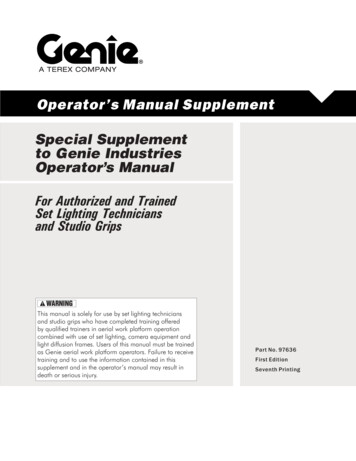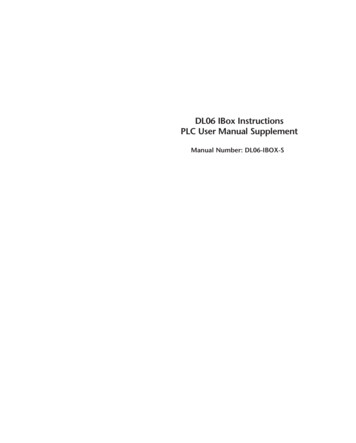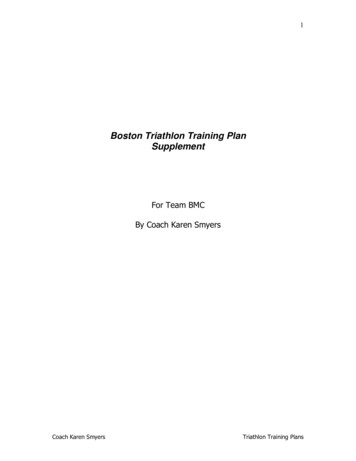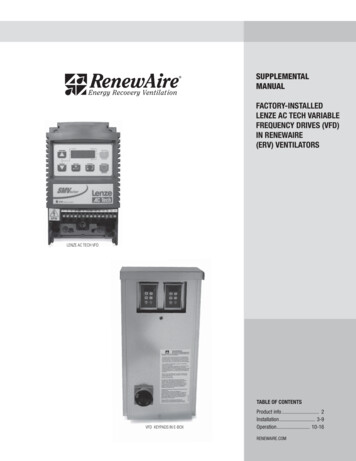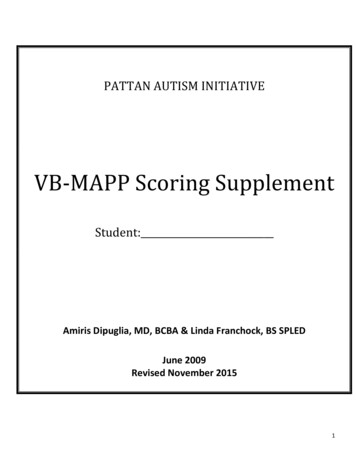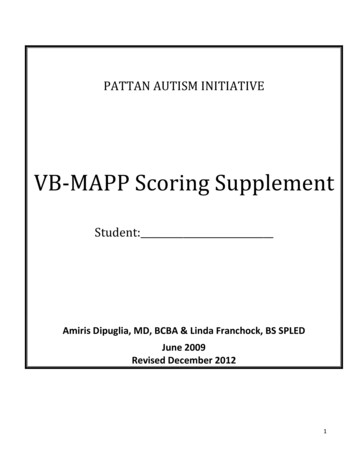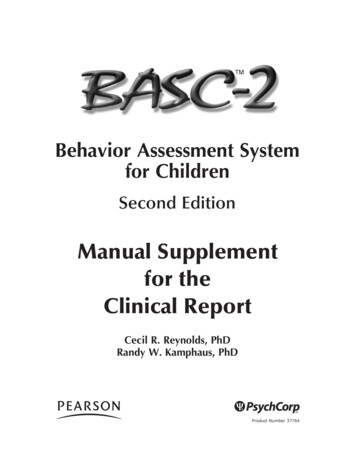
Transcription
Behavior Assessment Systemfor ChildrenSecond EditionManual Supplementfor theClinical ReportCecil R. Reynolds, PhDRandy W. Kamphaus, PhDProduct Number 37764
Pearson Executive Office 5601 Green Valley Drive Bloomington, MN 55437Copyright 2010 NCS Pearson, Inc. All rights reserved. This supplement may be printed out by the user of theBASC–2 Clinical Report. Reproduction or transmission in any other form or by any other means, electronic ormechanical, including photocopy, recording, or any information storage and retrieval system, may not be donewithout permission in writing from the copyright owner.Pearson, the PSI logo, PsychCorp, BASC, and Vineland are trademarks in the U.S. and/or other countriesof Pearson Education, Inc., or its affiliate(s). DSM–IV is a registered trademark of the American PsychiatricAssociation. Behavior Rating Inventory of Executive Function and BRIEF are registered trademarks ofPsychological Assessment Resources.Portions of this work were previously published.Information from the Diagnostic and Statistical Manual of Mental Disorders, Fourth Edition, Text Revision adaptedwith permission of the American Psychiatric Association, 2010.1 2 3 4 5 6 7 8 9 10 11 12 A B C D EFor orders and inquiries:Pearson Clinical Assessment, 19500 Bulverde Road, San Antonio, TX 78259800.627.7271 www.PsychCorp.com
Table of ContentsChapter 1: Introduction.1Features of the BASC–2 Clinical Report.1Uses of the BASC–2 Clinical Report.2Overview of the BASC–2 Clinical Report.2Interpretation.3Clinical Probability Index.3EBD Probability Index.5ADHD Probability Index.7Functional Impairment Index.9Chapter 2: Development of the Clinical Report Indexes andDSM–IV–TR Report Section. 13Development of the Clinical Probability Indexes and the Functional Impairment Index. 13Development of the Clinical Report Narrative. 14Development of the DSM–IV–TR Report Section. 15Chapter 3: Standardization, Reliability, and Validity. 16Standardization. 16Reliability. 17Internal Consistency. 17Test–Retest . . 21Interrater . .22Validity .22Correlations With Other BASC–2 Scales.23Correlations With Achenbach System of Empirically Based Assessment (ASEBA) Forms. 30Correlations With Conners’ Rating Scales–Revised Forms . 37Correlations With the Vineland Adaptive Behavior Scales, Second Edition (Vineland–II). 41Correlations With the Behavior Rating Inventory of Executive Function (BRIEF).44Correlations Between BASC–2 Forms.46Clinical Group Comparisons. 53References .56Appendix: Norms and Interpretive Tables for the Clinical Probability and FunctionalImpairment Indexes .57Table of Contentsiii
List of TablesTable 1.1 Clinical Probability Index Items for the TRS-P and PRS-P Forms. 4Table 1.2 EBD Probability Index Items for the TRS and PRS Child and Adolescent Forms. 6Table 1.3 ADHD Probability Index Items for the TRS and PRS Child and Adolescent Forms. 8Table 1.4 Functional Impairment Index Items for the TRS and PRS Forms. 10Table 1.5 Functional Impairment Index Items for the SRP Forms. 12Table 3.1 Skewness of Raw-Score Distributions, by Age Level (General Norm Samples) . 16Table 3.2 Coefficient Alpha Reliabilities of Indexes, by Sex and Norm Group,General Norm Samples.17Table 3.3 Coefficient Alpha Reliabilities of Indexes, by Sex and Norm Group,Clinical Norm Samples. 18Table 3.4 T Score Standard Errors of Measurement of Indexes, by Sex and Norm Group,General Norm Samples. 19Table 3.5 T Score Standard Errors of Measurement of Indexes, by Sex and Norm Group,Clinical Norm Samples . 20Table 3.6 PRS and SRP: Coefficient Alpha Reliabilities of Indexes for the Spanish Forms,by Sex and Test Form. 21Table 3.7 Test–Retest Reliabilities of Indexes, by Form Level. 21Table 3.8 TRS: Interrater Reliabilities of Indexes, by Form Level . 22Table 3.9 PRS: Interrater Reliabilities of Indexes, by Form Level. 22Table 3.10 TRS: Intercorrelation of Indexes, Composites, and Scales, General Norm Samples. 23Table 3.11 TRS: Intercorrelation of Indexes, Composites, and Scales, Clinical Norm Samples. 24Table 3.12 PRS: Intercorrelation of Indexes, Composites, and Scales, General Norm Samples. 25Table 3.13 PRS: Intercorrelation of Indexes, Composites, and Scales, Clinical Norm Samples. 26Table 3.14 SRP: Intercorrelation of Indexes, Composites, and Scales, General Norm Samples. 27Table 3.15 SRP: Intercorrelation of Indexes, Composites, and Scales, Clinical Norm Samples. 28Table 3.16 PRS: Intercorrelation of Indexes, Composites, and Scales for the Spanish Forms,General Norm Samples. 29Table 3.17 SRP: Intercorrelation of Indexes, Composites, and Scales for the Spanish Forms,General Norm Samples. 30Table 3.18 TRS-P: Correlations With the Achenbach System of Empirically Based Assessment CaregiverTeacher Report Form for Ages 1½–5.31Table 3.19 TRS-C: Correlations With the Achenbach System of Empirically Based Assessment Teacher’sReport Form for Ages 6–18. 32Table 3.20 TRS-A: Correlations With the Achenbach System of Empirically Based Assessment Teacher’sReport Form for Ages 6–18. 33List of Tablesiv
Table 3.21 PRS-P: Correlations With the Achenbach System of Empirically Based Assessment ChildBehavior Checklist for Ages 1½–5. 34Table 3.22 PRS-C: Correlations With the Achenbach System of Empirically Based Assessment ChildBehavior Checklist for Ages 6–18. 35Table 3.23 PRS-A: Correlations With the Achenbach System of Empirically Based Assessment ChildBehavior Checklist for Ages 6–18. 36Table 3.24 SRP-A: Correlations With the Achenbach System of Empirically Based AssessmentYouth Self-Report. 37Table 3.25 TRS-C: Correlations With the Conners’ Teacher Rating Scale–Revised. 38Table 3.26 TRS-A: Correlations With the Conners’ Teacher Rating Scale–Revised. 38Table 3.27 PRS-C: Correlations With the Conners’ Parent Rating Scale–Revised. 39Table 3.28 PRS-A: Correlations With the Conners’ Parent Rating Scale–Revised. 40Table 3.29 SRP-A: Correlations With the Conners–Wells’ Adolescent Self-Report Scale. 40Table 3.30 TRS-P: Correlations With the Vineland–II Teacher Rating Form. 41Table 3.31 TRS-C: Correlations With the Vineland–II Teacher Rating Form. 41Table 3.32 TRS-A: Correlations With the Vineland–II Teacher Rating Form. 42Table 3.33 PRS-P: Correlations With the Vineland–II Survey Form . 42Table 3.34 PRS-C: Correlations With the Vineland–II Survey Form . 43Table 3.35 PRS-A: Correlations With the Vineland–II Survey Form . 43Table 3.36 PRS-C: Correlations With the Behavior Rating Inventory ofExecutive Function Parent Form. 44Table 3.37 PRS-A: Correlations With the Behavior Rating Inventory ofExecutive Function Parent Form. 45Table 3.38 Correlations Between Preschool Forms for TRS and PRS Clinical Indexes and Scales. 46Table 3.39 Correlations Between Child Forms for TRS and PRS Clinical Indexes and Scales. 47Table 3.40 Correlations Between Adolescent Forms for TRS and PRS Clinical Indexes and Scales. 48Table 3.41 Correlations Between Child Forms for TRS and SRP Clinical Indexes and Scales. 49Table 3.42 Correlations Between Adolescent Forms for TRS and SRP Clinical Indexes and Scales. 50Table 3.43 Correlations Between Child Forms for PRS and SRP Clinical Indexes and Scales. 51Table 3.44 Correlations Between Adolescent Forms for PRS and SRP Clinical Indexes and Scales. 52Table 3.45 Mean T Scores by Clinical Group. 54Table 3.46 Clinical Probability Index Mean Score Difference Between the Matched Clinical andNonclinical Samples for the Item Development and Cross-Validation Samples. 55BASC–2 Manual Supplement for the Clinical ReportList of Tablesv
Chapter1IntroductionThe Behavior Assessment System for Children, Second Edition (BASC –2) Teacher Rating Scales (TRS), ParentRating Scales (PRS), and Self-Report of Personality (SRP) are three of the most widely used tools for assessingbehavioral and emotional problems in children and adolescents ages 2 ½ years through 21 years, in both school andclinical settings. This BASC–2 manual supplement describes the purpose, development, interpretation, and technicalproperties of the newly developed BASC–2 Clinical Report. Clinicians and practitioners interested in similarinformation for the BASC–2 TRS, PRS, and SRP should consu
BASC–2 Manual Supplement for the Clinical Report List of Tables v. 1 Introduction The Behavior Assessment System for Children, Second Edition (BASC –2) Teacher Rating Scales (TRS), Parent Rating Scales (PRS), and Self-Report of Personality (SRP) are three of the most widely used tools for assessing behavioral and emotional problems in children and adolescents ages 2 ½ years through 21 .File Size: 1MBPage Count: 158
